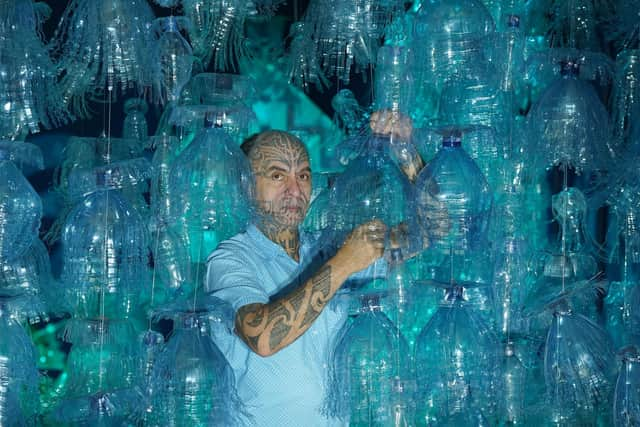How artist George Nuku is tackling plastic pollution one installation at a time
The National Museum of Scotland is currently playing host to an exhibition called Rising Tides: Art and Environment in Oceania. The blurb describes it as “showcasing artworks created in response to the climate crisis in Australia and the Pacific Islands”, and certainly some of the work on show speaks to this; however, there is also a significant secondary theme: plastic.
The centrepiece of the show is an enormous, room-sized installation by the Maori-Scottish-German artist George Nuku. Titled Bottled Ocean 2123, it is made entirely out of plastic waste. Two fierce-looking hammerhead sharks, their bodies made out of transparent blue plastic water drums, swim overhead, pursuing a school of fish; a pair of jellyfish sway in the draft of a strategically positioned fan, their tentacles constructed out of scores of clear plastic water bottles all threaded together. Nearby, a sea turtle with a beautifully patterned shell swims through a green-and-blue plastic bottle ocean. In the centre of it all is a traditional double-hulled Maori canoe, a waka hourua, sturdily constructed above a base of yet more plastic water drums, but carrying within its little hut-like cabin a human skull. Is this how it will all end?, the piece seems to be asking, with the last vestiges of human civilisation left bobbing on a sterile, plastic-choked ocean?
Advertisement
Hide AdAdvertisement
Hide AdNuku's installation isn't easy to look at, for various reasons. Firstly, there's a lot going on: as you walk into the space though a gently rustling screen of shredded plastic, you're hit with a huge amount of visual information, to the point of information overload; secondly, because everything is rendered in the same translucent blues and greens that Nuku was able to salvage for the piece, and lit in similar colours, it takes a while to adjust to what you're looking at and start to make sense of it all – to separate the clumps of plastic bottle seaweed from the plastic bottle sea.


The third reason it's hard to look at, though, is because somewhere buried within the 21st century Western psyche is a deep distaste, almost bordering on disgust, for the sight of plastic waste. Distaste and also a measure of guilt. When we see a plastic bottle blowing along the street on a windy day, how many of us stop to pick it up before looking for a recycling bin? And how many of us think, "there are millions more bottles like that one, what's the point?" before looking away and walking on? The act of looking away from plastic waste, then, is a protection mechanism – a way of protecting ourselves from that gnawing combination of guilt and helplessness. When confronted by Nuku's installation, however, you're practically immersed in plastic. Even if you wanted to look away, apart from a few plastic-free patches of floor and ceiling, there aren't many places to look away to, and so, by forcing you to look, Nuku also forces you to think.
What he wants you to think about, exactly, is hinted at in a video interview playing at five minute intervals alongside the work. In one telling passage, Nuku suggests that in the past, when societies became very reliant on or in thrall to a particular material, they would eventually incorporate it into their culture by way of myths, legends and rituals (think of the Aztecs and their gold, the Haida and their cedar wood, and so on.) Our civilisation is now massively reliant on plastic, to the extent that it would probably come to a grinding halt overnight without it, and yet we attribute zero value to it. Less than zero. The idea that we could ever treat it as a material worthy of being incorporated into sacred stories is laughable, yet, to an alien observing us from another planet, that might not seem so strange.
Nuku's own approach to single-use plastic, he explains in the interview, is to treat it as something very valuable. He describes the act of scavenging for plastic bottles on the streets of France, where he spends time when not in Aotearoa/New Zealand, as like hunting for "treasure" and he enthuses about the wonderful colours the French have for their water bottles.
This approach to plastic waste is echoed elsewhere in the show. Florence Gutchen, Racy Oui-Pitt and Jimmy John Thaiday of the Torres Strait Islands take ghost nets (discarded fishing nets, which can be hazardous to marine life) and turn them into sculptures – in the show, a jellyfish, an angelfish and a very characterful sea turtle. Similarly, Guam fisherman Anthony C Guerrero uses traditional weaving techniques to make stylish bags and baskets from plastic construction strapping found littering his local beach, and there are also examples of traditional headdresses from Kiribati made out of recycled plastic drinking straws. Should we all start thinking of waste plastic as treasure? Perhaps that’s not as crazy as it sounds.
Rising Tides: Art and Environment in Oceania is at the National Museum of Scotland, Edinburgh, until 14 April 2024.
